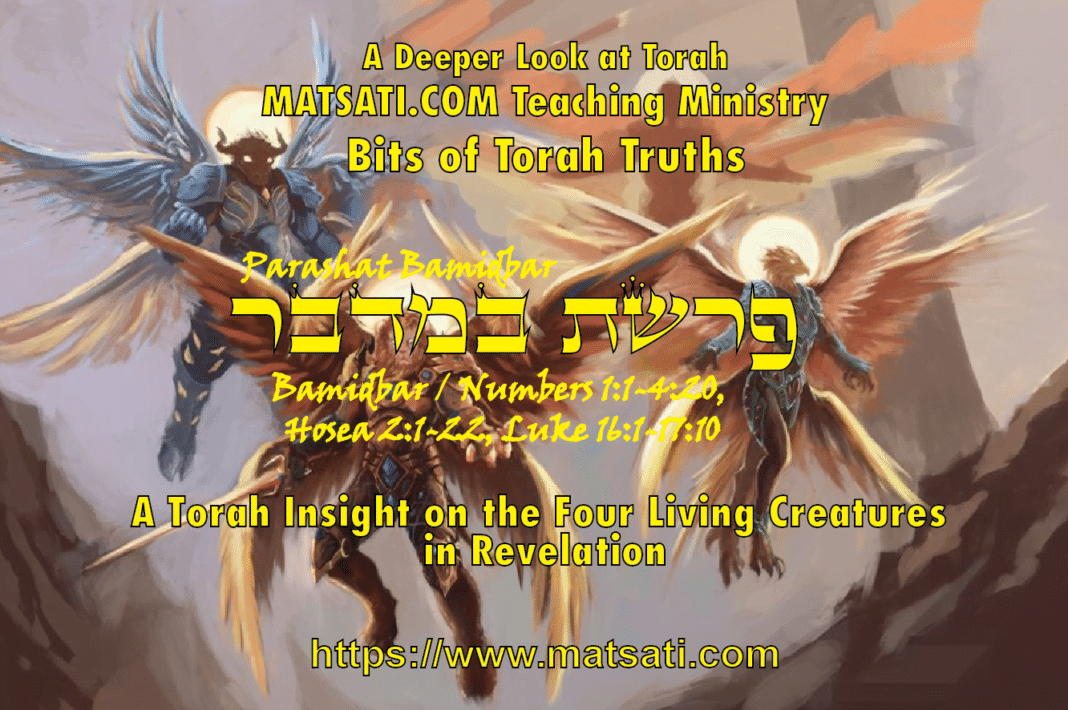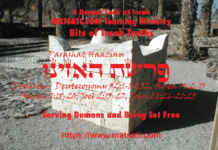This week’s Torah Portion, Parashat Bamidbar, covers the opening chapters of the book of Numbers. Bamidbar / Numbers 1-4 describe Moshe taking a census of Israel’s warriors (1:1-44), how the Levites are exempted from the census (1:47-54), the arrangement of the camp surrounding the Mishkhan (Tabernacle, 2:1-34), a discussion on the sons of Aaron and the duties of the Levities (3:1-39), a discussion on the redemption of the first born of Israel (3:40-51), and the duties and responsibilities of the Kohathites, Gershonites, and Merarites (4:1-49). The opening verses in Bamidbar / Numbers 2:1-3, state the following: א וַיְדַבֵּר יְהֹוָה אֶל-מֹשֶׁה וְאֶל-אַהֲרֹן לֵאמֹר: ב אִישׁ עַל-דִּגְלוֹ בְאֹתֹת לְבֵית אֲבֹתָם יַחֲנוּ בְּנֵי יִשְֹרָאֵל מִנֶּגֶד סָבִיב לְאֹהֶל-מוֹעֵד יַחֲנוּ: ג וְהַחֹנִים קֵדְמָה מִזְרָחָה דֶּגֶל מַחֲנֵה יְהוּדָה לְצִבְאֹתָם וְנָשִֹיא לִבְנֵי יְהוּדָה נַחְשׁוֹן בֶּן-עַמִּינָדָב: 2:1 The Lord spoke to Moses and Aaron, saying, 2 “The people of Israel shall camp each by his own standard, with the banners of their fathers’ houses. They shall camp facing the tent of meeting on every side. 3 Those to camp on the east side toward the sunrise shall be of the standard of the camp of Judah by their companies, the chief of the people of Judah being Nahshon the son of Amminadab. (ESV) It is interesting here the description of each tribe having her own standard or banner. Some of the rabbis say the standard (דִּגְלוֹ) had a symbol of a letter, others say they had pictures of people and animals. This is what Ibn Ezra thought according to his commentary.
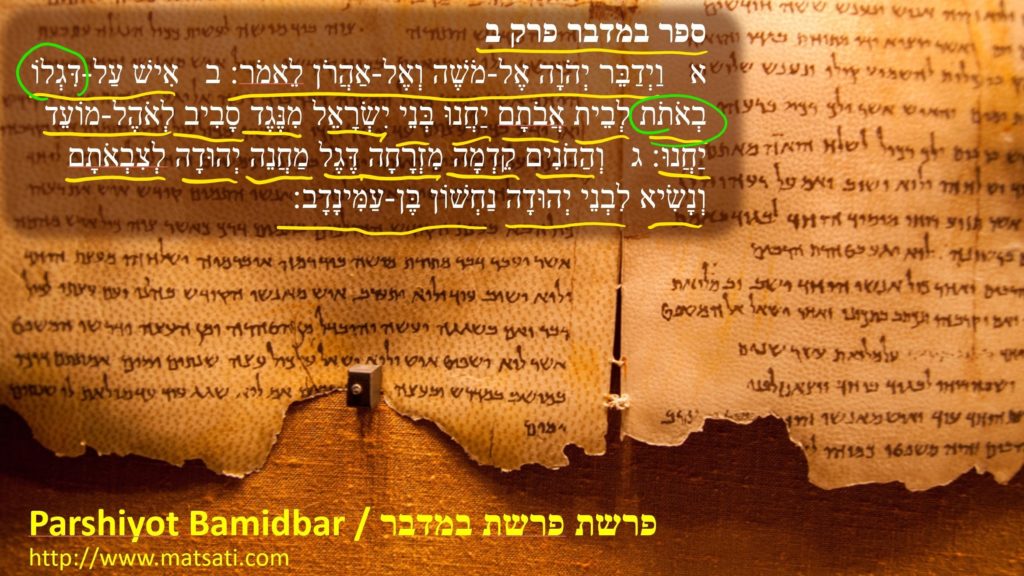
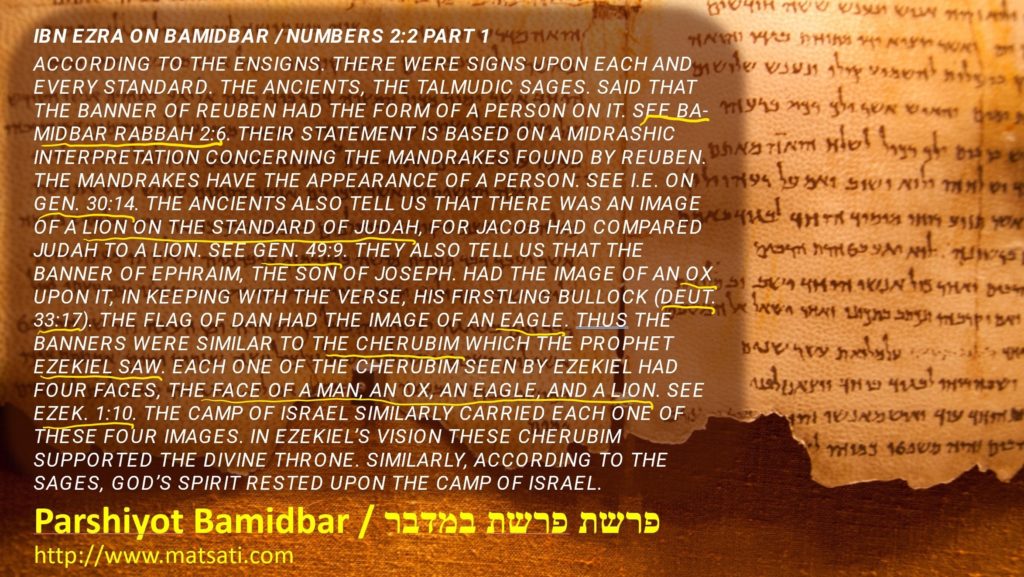
Ibn Ezra on Bamidbar / Numbers 2:2 Part 1
ACCORDING TO THE ENSIGNS. There were signs upon each and every standard. The ancients, The Talmudic sages. said that the banner of Reuben had the form of a person on it. See Ba-Midbar Rabbah 2:6. Their statement is based on a midrashic interpretation concerning the mandrakes found by Reuben. The mandrakes have the appearance of a person. See I.E. on Gen. 30:14. The ancients also tell us that there was an image of a lion on the standard of Judah, for Jacob had compared Judah to a lion. See Gen. 49:9. They also tell us that the banner of Ephraim, The son of Joseph. had the image of an ox upon it, in keeping with the verse, His firstling bullock (Deut. 33:17). The flag of Dan had the image of an eagle. Thus the banners were similar to the cherubim which the prophet Ezekiel saw. Each one of the cherubim seen by Ezekiel had four faces, the face of a man, an ox, an eagle, and a lion. See Ezek. 1:10. The camp of Israel similarly carried each one of these four images. In Ezekiel’s vision these cherubim supported the divine throne. Similarly, according to the sages, God’s spirit rested upon the camp of Israel.
The rabbis reasoned about the banners and what exactly was on the banners for each tribe. Ibn Ezra uses scripture to show there was some spiritual significance to the symbolism on the banner which was represented differently for each tribe via an animal or a person using a scripture reference. Note that each of the three groups of tribes were positioned surrounding the Tabernacle (North, East, South, and West). The troubling thing about this kind of interpretation is what we read in Shemot / Exodus 20 not to make an image of anything in heaven or on earth. From a rabbinic kabbalistic approach, the Israelites wished for flags similar to those of the angels. Rabbeinu Bahya looks at these verses and particularly the phrase אִישׁ עַל-דִּגְלוֹ בְאֹתֹת and the word בְאֹתֹת saying this is related to the word אַוַּ֥ת as in אות נפשו, “the desire of his soul,” or the phrase בכל אות נפשך, “in accordance with all you desire” referencing Devarim / Deuteronomy 12:20 (כִּֽי־יַרְחִיב֩ יְהוָ֨ה אֱלֹהֶ֥יךָ אֶֽת־גְּבֽוּלְךָ֮ כַּאֲשֶׁ֣ר דִּבֶּר־לָךְ֒ וְאָמַרְתָּ֙ אֹכְלָ֣ה בָשָׂ֔ר כִּֽי־תְאַוֶּ֥ה נַפְשְׁךָ֖ לֶאֱכֹ֣ל בָּשָׂ֑ר בְּכָל־אַוַּ֥ת נַפְשְׁךָ֖ תֹּאכַ֥ל בָּשָֽׂר׃). Shir Hashirim Rabbah 2,13 on the words ודגלו אהבה discusses how when God descended on Sinai and the angels descended they did so with banners / standards / flags. Since this time Israel had observed angels, they had the urgent or desire to have banners also. (Tanchuma Bamidbar 14) Chizkuni on Bamidbar / Numbers 2:2 Part 1 states the phrase אִישׁ עַל-דִּגְלוֹ בְאֹתֹת means “every man with his own standard according to the insignias of his father’s house;” the flags had the names of their forefather’s houses inscribed upon them. In addition to these things, the rabbis say Judah represented Torah, followed by the camp of Reuven which represented repentance, and the camp of Ephraim which represented the attribute גבורה (gevurah, power/strength). They say this camp corresponded to the celestial camp headed by the archangel Raphael supported by the angels Zavdiel and Achziel which was situated immediately behind the Shechinah. This was the camp that Moshe alluded to when he prayed that Miriam be healed from her tzoraat by saying אֵ֕ל נָ֛א רְפָ֥א נָ֖א לָֽהּ, “please God heal her now,” (Bamidbar / Numbers 12:13, וַיִּצְעַ֣ק מֹשֶׁ֔ה אֶל־יְהוָ֖ה לֵאמֹ֑ר אֵ֕ל נָ֛א רְפָ֥א נָ֖א לָֽהּ) He appealed to the attribute having angelic representation. (Rabbeinu Bahya on Bamidbar / Numbers 2:2 Part 8) It is interesting how all of these things are drawn out from the Torah text on the banners and the interpretation based upon rabbinical tradition, the standard of Judah bore the figure of a lion, that of Reuben the likeness of a man or of a man’s head, that of Ephraim the figure of an ox, and that of Dan the figure of an eagle; these banners represent the four groups of peoples that were commanded to surround the Mishkhan (Tabernacle) and these banners are said to also represent the four living creatures united in the cherubic forms described by Ezekiel. The idea is at the entrance of the Mishkhan which points to the east, the standard, flag, or banner represents the four living creatures which surround the Tabernacle. Jewish tradition says the “four standards” under which Israel encamped in the wilderness in the four directions surrounding the Mishkhan (lion, eagle, ox, and man) the Mishkhan while in their midst contained the Shekinah the Divine Presence of God. The Tabernacle located in the center, was flanked by all these camps, and was a symbol of the holy angels called chayot (living creatures), which surround the throne of God forming a square. (Bamidbar Rabbah 2:6) All of these things provide us with insights into the four living creatures described for us according to the book of Revelation.
The verses we are looking at for this week are from Bamidbar / Numbers 2.
ספר במדבר פרק ב
א וַיְדַבֵּר יְהֹוָה אֶל-מֹשֶׁה וְאֶל-אַהֲרֹן לֵאמֹר: ב אִישׁ עַל-דִּגְלוֹ בְאֹתֹת לְבֵית אֲבֹתָם יַחֲנוּ בְּנֵי יִשְֹרָאֵל מִנֶּגֶד סָבִיב לְאֹהֶל-מוֹעֵד יַחֲנוּ: ג וְהַחֹנִים קֵדְמָה מִזְרָחָה דֶּגֶל מַחֲנֵה יְהוּדָה לְצִבְאֹתָם וְנָשִֹיא לִבְנֵי יְהוּדָה נַחְשׁוֹן בֶּן-עַמִּינָדָב: ד וּצְבָאוֹ וּפְקֻדֵיהֶם אַרְבָּעָה וְשִׁבְעִים אֶלֶף וְשֵׁשׁ מֵאוֹת: ה וְהַחֹנִים עָלָיו מַטֵּה יִשָּׂשֹכָר וְנָשִֹיא לִבְנֵי יִשָּׂשֹכָר נְתַנְאֵל בֶּן-צוּעָר: ו וּצְבָאוֹ וּפְקֻדָיו אַרְבָּעָה וַחֲמִשִּׁים אֶלֶף וְאַרְבַּע מֵאוֹת: ז מַטֵּה זְבוּלֻן וְנָשִֹיא לִבְנֵי זְבוּלֻן אֱלִיאָב בֶּן-חֵלֹן: ח וּצְבָאוֹ וּפְקֻדָיו שִׁבְעָה וַחֲמִשִּׁים אֶלֶף וְאַרְבַּע מֵאוֹת: ט כָּל-הַפְּקֻדִים לְמַחֲנֵה יְהוּדָה מְאַת אֶלֶף וּשְׁמֹנִים אֶלֶף וְשֵׁשֶׁת-אֲלָפִים וְאַרְבַּע-מֵאוֹת לְצִבְאֹתָם רִאשֹׁנָה יִסָּעוּ: ס י דֶּגֶל מַחֲנֵה רְאוּבֵן תֵּימָנָה לְצִבְאֹתָם וְנָשִֹיא לִבְנֵי רְאוּבֵן אֱלִיצוּר בֶּן-שְׁדֵיאוּר: יא וּצְבָאוֹ וּפְקֻדָיו שִׁשָּׁה וְאַרְבָּעִים אֶלֶף וַחֲמֵשׁ מֵאוֹת: יב וְהַחוֹנִם עָלָיו מַטֵּה שִׁמְעוֹן וְנָשִֹיא לִבְנֵי שִׁמְעוֹן שְׁלֻמִיאֵל בֶּן-צוּרִישַׁדָּי: יג וּצְבָאוֹ וּפְקֻדֵיהֶם תִּשְׁעָה וַחֲמִשִּׁים אֶלֶף וּשְׁלֹשׁ מֵאוֹת: יד וּמַטֵּה גָּד וְנָשִֹיא לִבְנֵי גָד אֶלְיָסָף בֶּן-רְעוּאֵל: טו וּצְבָאוֹ וּפְקֻדֵיהֶם חֲמִשָּׁה וְאַרְבָּעִים אֶלֶף וְשֵׁשׁ מֵאוֹת וַחֲמִשִּׁים: טז כָּל-הַפְּקֻדִים לְמַחֲנֵה רְאוּבֵן מְאַת אֶלֶף וְאֶחָד וַחֲמִשִּׁים אֶלֶף וְאַרְבַּע-מֵאוֹת וַחֲמִשִּׁים לְצִבְאֹתָם וּשְׁנִיִּם יִסָּעוּ: ס יז וְנָסַע אֹהֶל-מוֹעֵד מַחֲנֵה הַלְוִיִּם בְּתוֹךְ הַמַּחֲנֹת כַּאֲשֶׁר יַחֲנוּ כֵּן יִסָּעוּ אִישׁ עַל-יָדוֹ לְדִגְלֵיהֶם: ס יח דֶּגֶל מַחֲנֵה אֶפְרַיִם לְצִבְאֹתָם יָמָּה וְנָשִֹיא לִבְנֵי אֶפְרַיִם אֱלִישָׁמָע בֶּן-עַמִּיהוּד: יט וּצְבָאוֹ וּפְקֻדֵיהֶם אַרְבָּעִים אֶלֶף וַחֲמֵשׁ מֵאוֹת: כ וְעָלָיו מַטֵּה מְנַשֶּׁה וְנָשִֹיא לִבְנֵי מְנַשֶּׁה גַּמְלִיאֵל בֶּן-פְּדָהצוּר: כא וּצְבָאוֹ וּפְקֻדֵיהֶם שְׁנַיִם וּשְׁלֹשִׁים אֶלֶף וּמָאתָיִם: כב וּמַטֵּה בִּנְיָמִן וְנָשִֹיא לִבְנֵי בִנְיָמִן אֲבִידָן בֶּן-גִּדְעֹנִי: כג וּצְבָאוֹ וּפְקֻדֵיהֶם חֲמִשָּׁה וּשְׁלֹשִׁים אֶלֶף וְאַרְבַּע מֵאוֹת: כד כָּל-הַפְּקֻדִים לְמַחֲנֵה אֶפְרַיִם מְאַת אֶלֶף וּשְׁמֹנַת-אֲלָפִים וּמֵאָה לְצִבְאֹתָם וּשְׁלִשִׁים יִסָּעוּ: ס כה דֶּגֶל מַחֲנֵה דָן צָפֹנָה לְצִבְאֹתָם וְנָשִֹיא לִבְנֵי דָן אֲחִיעֶזֶר בֶּן-עַמִּישַׁדָּי: כו וּצְבָאוֹ וּפְקֻדֵיהֶם שְׁנַיִם וְשִׁשִּׁים אֶלֶף וּשְׁבַע מֵאוֹת: כז וְהַחֹנִים עָלָיו מַטֵּה אָשֵׁר וְנָשִֹיא לִבְנֵי אָשֵׁר פַּגְעִיאֵל בֶּן-עָכְרָן: כח וּצְבָאוֹ וּפְקֻדֵיהֶם אֶחָד וְאַרְבָּעִים אֶלֶף וַחֲמֵשׁ מֵאוֹת: כט וּמַטֵּה נַפְתָּלִי וְנָשִֹיא לִבְנֵי נַפְתָּלִי אֲחִירַע בֶּן-עֵינָן: ל וּצְבָאוֹ וּפְקֻדֵיהֶם שְׁלֹשָׁה וַחֲמִשִּׁים אֶלֶף וְאַרְבַּע מֵאוֹת: לא כָּל-הַפְּקֻדִים לְמַחֲנֵה דָן מְאַת אֶלֶף וְשִׁבְעָה וַחֲמִשִּׁים אֶלֶף וְשֵׁשׁ מֵאוֹת לָאַחֲרֹנָה יִסְעוּ לְדִגְלֵיהֶם: פ לב אֵלֶּה פְּקוּדֵי בְנֵי-יִשְֹרָאֵל לְבֵית אֲבֹתָם כָּל-פְּקוּדֵי הַמַּחֲנֹת לְצִבְאֹתָם שֵׁשׁ-מֵאוֹת אֶלֶף וּשְׁלֹשֶׁת אֲלָפִים וַחֲמֵשׁ מֵאוֹת וַחֲמִשִּׁים: לג וְהַלְוִיִּם לֹא הָתְפָּקְדוּ בְּתוֹךְ בְּנֵי יִשְֹרָאֵל כַּאֲשֶׁר צִוָּה יְהוָֹה אֶת-מֹשֶׁה: לד וַיַּעֲשֹוּ בְּנֵי יִשְֹרָאֵל כְּכֹל אֲשֶׁר-צִוָּה יְהֹוָה אֶת-מֹשֶׁה כֵּן-חָנוּ לְדִגְלֵיהֶם וְכֵן נָסָעוּ אִישׁ לְמִשְׁפְּחֹתָיו עַל-בֵּית אֲבֹתָיו:
Bamidbar / Numbers 2:1-34
2 The Lord spoke to Moses and Aaron, saying, 2 “The people of Israel shall camp each by his own standard, with the banners of their fathers’ houses. They shall camp facing the tent of meeting on every side. 3 Those to camp on the east side toward the sunrise shall be of the standard of the camp of Judah by their companies, the chief of the people of Judah being Nahshon the son of Amminadab, 4 his company as listed being 74,600. 5 Those to camp next to him shall be the tribe of Issachar, the chief of the people of Issachar being Nethanel the son of Zuar, 6 his company as listed being 54,400. 7 Then the tribe of Zebulun, the chief of the people of Zebulun being Eliab the son of Helon, 8 his company as listed being 57,400. 9 All those listed of the camp of Judah, by their companies, were 186,400. They shall set out first on the march. 10 “On the south side shall be the standard of the camp of Reuben by their companies, the chief of the people of Reuben being Elizur the son of Shedeur, 11 his company as listed being 46,500. 12 And those to camp next to him shall be the tribe of Simeon, the chief of the people of Simeon being Shelumiel the son of Zurishaddai, 13 his company as listed being 59,300. 14 Then the tribe of Gad, the chief of the people of Gad being Eliasaph the son of Reuel, 15 his company as listed being 45,650. 16 All those listed of the camp of Reuben, by their companies, were 151,450. They shall set out second. 17 “Then the tent of meeting shall set out, with the camp of the Levites in the midst of the camps; as they camp, so shall they set out, each in position, standard by standard. 18 “On the west side shall be the standard of the camp of Ephraim by their companies, the chief of the people of Ephraim being Elishama the son of Ammihud, 19 his company as listed being 40,500. 20 And next to him shall be the tribe of Manasseh, the chief of the people of Manasseh being Gamaliel the son of Pedahzur, 21 his company as listed being 32,200. 22 Then the tribe of Benjamin, the chief of the people of Benjamin being Abidan the son of Gideoni, 23 his company as listed being 35,400. 24 All those listed of the camp of Ephraim, by their companies, were 108,100. They shall set out third on the march. 25 “On the north side shall be the standard of the camp of Dan by their companies, the chief of the people of Dan being Ahiezer the son of Ammishaddai, 26 his company as listed being 62,700. 27 And those to camp next to him shall be the tribe of Asher, the chief of the people of Asher being Pagiel the son of Ochran, 28 his company as listed being 41,500. 29 Then the tribe of Naphtali, the chief of the people of Naphtali being Ahira the son of Enan, 30 his company as listed being 53,400. 31 All those listed of the camp of Dan were 157,600. They shall set out last, standard by standard.” 32 These are the people of Israel as listed by their fathers’ houses. All those listed in the camps by their companies were 603,550. 33 But the Levites were not listed among the people of Israel, as the Lord commanded Moses. 34 Thus did the people of Israel. According to all that the Lord commanded Moses, so they camped by their standards, and so they set out, each one in his clan, according to his fathers’ house. (ESV)
The things we learn from Jewish tradition according to the opening chapters of the book of Bamidbar / Numbers provide us some insight into why there were four living creatures represented in both Ezekiel 1:5, 1:10, and Revelation 4:6-7. The four living creatures are mentioned in all of these verses according to Revelation 4:6-8, 5:6-8, 5:11, 5:14, 6:1, 6:6, 7:11, 14:3, 15:7, 19:4. Let’s look at a few of these:
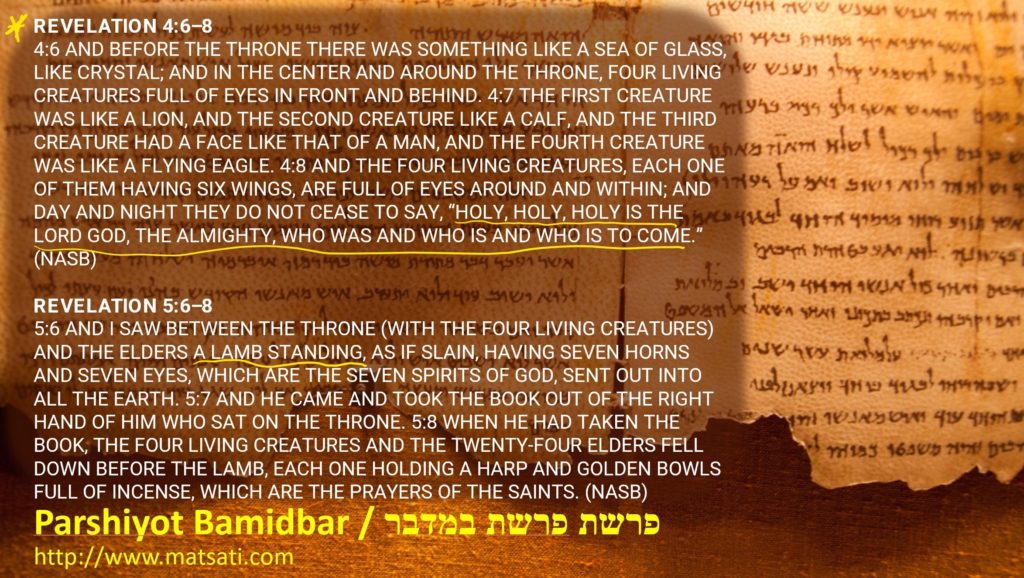
Revelation 4:6–8
4:6 and before the throne there was something like a sea of glass, like crystal; and in the center and around the throne, four living creatures full of eyes in front and behind. 4:7 The first creature was like a lion, and the second creature like a calf, and the third creature had a face like that of a man, and the fourth creature was like a flying eagle. 4:8 And the four living creatures, each one of them having six wings, are full of eyes around and within; and day and night they do not cease to say, “Holy, holy, holy is the Lord God, the Almighty, who was and who is and who is to come.” (NASB)
Revelation 5:6–8
5:6 And I saw between the throne (with the four living creatures) and the elders a Lamb standing, as if slain, having seven horns and seven eyes, which are the seven Spirits of God, sent out into all the earth. 5:7 And He came and took the book out of the right hand of Him who sat on the throne. 5:8 When He had taken the book, the four living creatures and the twenty-four elders fell down before the Lamb, each one holding a harp and golden bowls full of incense, which are the prayers of the saints. (NASB)
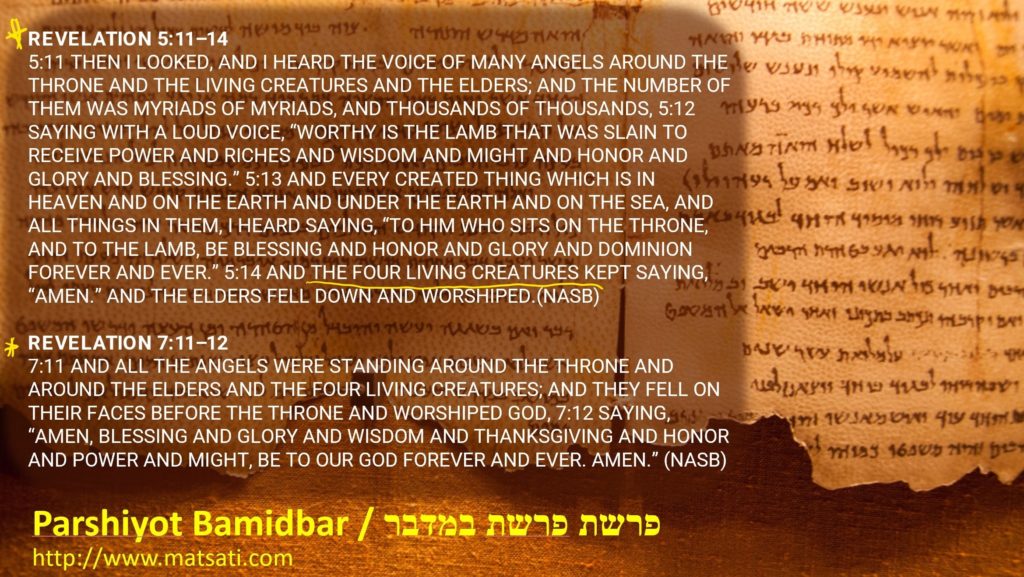
Revelation 5:11–14
5:11 Then I looked, and I heard the voice of many angels around the throne and the living creatures and the elders; and the number of them was myriads of myriads, and thousands of thousands, 5:12 saying with a loud voice, “Worthy is the Lamb that was slain to receive power and riches and wisdom and might and honor and glory and blessing.” 5:13 And every created thing which is in heaven and on the earth and under the earth and on the sea, and all things in them, I heard saying, “To Him who sits on the throne, and to the Lamb, be blessing and honor and glory and dominion forever and ever.” 5:14 And the four living creatures kept saying, “Amen.” And the elders fell down and worshiped.(NASB)
Revelation 7:11–12
7:11 And all the angels were standing around the throne and around the elders and the four living creatures; and they fell on their faces before the throne and worshiped GOD, 7:12 saying, “Amen, blessing and glory and wisdom and thanksgiving and honor and power and might, be to our God forever and ever. Amen.” (NASB)
Notice the way Revelation 7:11-12 is written, it appears the throne of God is at the center and the living creatures surround the throne, followed by the elders, then the angels, and then the men of every nation and tribe. This is consistent with the rabbinic Midrashic interpretation which states the Tabernacle located in the center, was flanked by all these camps, and was a symbol of the holy angels called chayot (living creatures), which surround the throne of God forming a square. (Bamidbar Rabbah 2:6) Note also how chayot (living creatures) are a symbol of power and strength to make war. This is consistent with the angels pouring out the bowls of God’s wrath upon the nations, as we read both the Tanach and the book of Revelation.
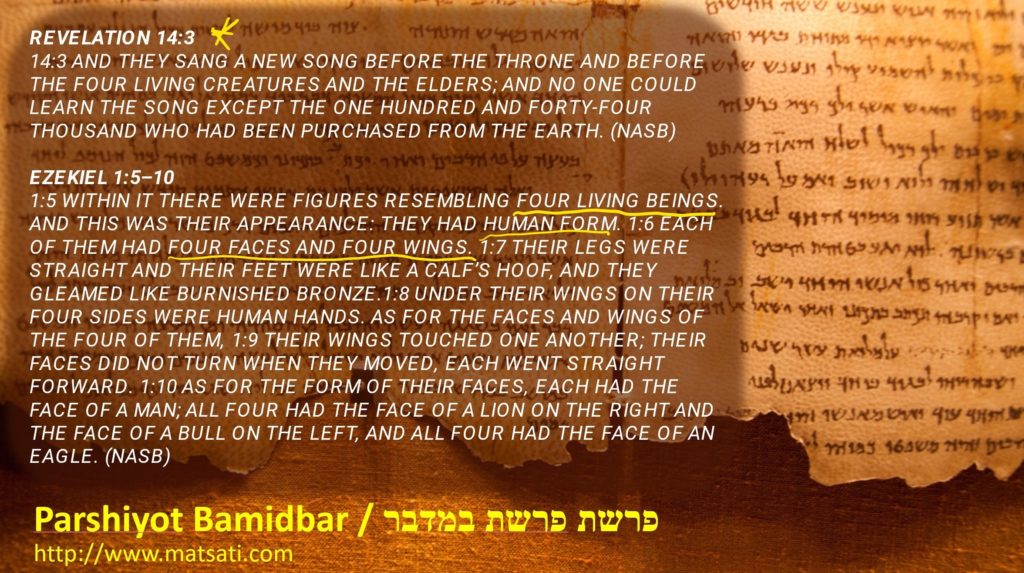
Revelation 14:3
14:3 And they sang a new song before the throne and before the four living creatures and the elders; and no one could learn the song except the one hundred and forty-four thousand who had been purchased from the earth. (NASB)
Notice when giving praise to God and to the lamb the Living creatures are present. These things suggest the living creatures are what sets the bounds of the Shekhinah glory of God in the Mishkhan that is in heaven if we can draw a parallel to the organization of the people and the Mishkhan in the wilderness. We also note how these living creatures are agents of God, who also have the characteristics of God when we compare Ezekiel 1:
Ezekiel 1:5–10
1:5 Within it there were figures resembling four living beings. And this was their appearance: they had human form. 1:6 Each of them had four faces and four WINGS. 1:7 Their legs were straight and their feet were like a calf’s hoof, and they gleamed like burnished bronze.1:8 Under their wings on their four sides were human hands. As for the faces and wings of the four of THEM, 1:9 their wings touched one another; their faces did not turn when they moved, each went straight FORWARD. 1:10 As for the form of their faces, each had the face of a man; all four had the face of a lion on the right and the face of a bull on the left, and all four had the face of an eagle. (NASB)
We note that these are the angels that Ezekiel identifies as the Cherubim in Ezekiel 1:15 and 1:20. (Ezekiel 1:20 Wherever the spirit would go, they would go, and the wheels would rise along with them, because the spirit of the living creatures was in the wheels. NASB) We note how Ezekiel 1:20 states that the Spirit would go with the chayot. This is consistent with the four living creatures representing the Shekhina glory of God which surrounded the Mishkhan (Tabernacle) and dwelled in the midst of God’s people represented by the encampment surrounding the Mishkhan on all sides. The way the Torah commands these things to be organized, demonstrates how the God of Israel is to be at the center of our lives and all that we are. Isaiah describes these angels as Seraphim saying:
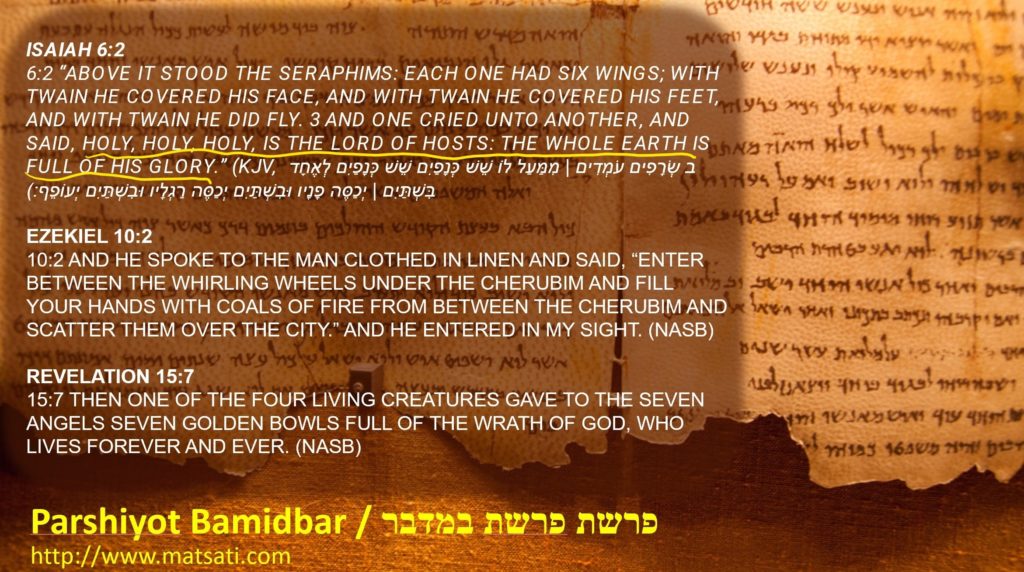
Isaiah 6:2
6:2 “Above it stood the seraphims: each one had six wings; with twain he covered his face, and with twain he covered his feet, and with twain he did fly. 3 And one cried unto another, and said, Holy, holy, holy, is the Lord of hosts: the whole earth is full of his glory.” (KJV, ב שְֹרָפִים עֹמְדִים | מִמַּעַל לוֹ שֵׁשׁ כְּנָפַיִם שֵׁשׁ כְּנָפַיִם לְאֶחָד בִּשְׁתַּיִם | יְכַסֶּה פָנָיו וּבִשְׁתַּיִם יְכַסֶּה רַגְלָיו וּבִשְׁתַּיִם יְעוֹפֵף:)
Remember the Hebrew word for Seraphim, שְׂרָפִ֨ים from the root שרף which has meaning “the burning effect from poison” coupled with Isaiah 1:15 (Ezekiel 1:13 וּדְמ֨וּת הַחַיּ֜וֹת מַרְאֵיהֶ֣ם כְּגַחֲלֵי־אֵ֗שׁ בֹּֽעֲרוֹת֙ כְּמַרְאֵ֣ה הַלַּפִּדִ֔ים הִ֕יא מִתְהַלֶּ֖כֶת בֵּ֣ין הַחַיּ֑וֹת וְנֹ֣גַהּ לָאֵ֔שׁ וּמִן־הָאֵ֖שׁ יוֹצֵ֥א בָרָֽק׃ “The appearance of the living creatures was like burning coals of fire or like torches. Fire moved back and forth among the creatures; it was bright, and lightning flashed out of it.”) They fly where God wills them to go (Ezekiel 1:12, 20). They hand out coals of fire, which are the judgments from God (Isaiah 6:6, Ezekiel 10:2). This is how John describes the Living creatures according to Revelation 15:7. We note in Revelation 15:8 the text states “And the temple was filled with smoke from the glory of God and from His power; and no one was able to enter the temple until the seven plagues of the seven angels were finished.” (NASB) These things explain to us how there is a temple in heaven and there were those who went in and out of that temple in heaven. This is the image that God told Moshe to make the earthly copy from the heavenly original. The throne of God appears to be at the center of that temple. All of these things are represented in the wilderness tabernacle over the mercy seat in the holy of holies (Shemot / Exodus 25:18-20), which is said to be the earthly copy representing the throne of God. John’s vision is similar to that of Ezekiel’s, with an interesting variation. John shows the creatures as having six wings and Ezekiel as having four. John is not alone in this difference. Isaiah also recorded these same beings as having six wings. (Isaiah 6:2) Midrash Tanchuma, Emor 16:1 (מדרש תנחומא, אמור ט״ז:א׳) states that it was for the atonement of Israel that He added two more wings to them. Thus it is stated , “each of them had six wings.” (Townsend 1989 translation of Midrash Tanhuma, S. Buber Recension, edited and supplemented by R. Francis Nataf)
Comparing Ezekiel 10:2 with Revelation 15:7 we read the following:
Ezekiel 10:2
10:2 And He spoke to the man clothed in linen and said, “Enter between the whirling wheels under the cherubim and fill your hands with coals of fire from between the cherubim and scatter them over the city.” And he entered in my sight. (NASB)
Revelation 15:7
15:7 Then one of the four living creatures gave to the seven angels seven golden bowls full of the wrath of God, who lives forever and ever. (NASB)
Note in Ezekiel, this is a Torah perspective on the priesthood taking the coals from the fire on the altar. Notice how the altar is between these living creatures, and this again is a description of how the creatures surround the Tabernacle as symbolically representing both the people of God according to the Torah, and the shekhina glory of God. We see this pictured in the heavenly region as the living creatures surround the throne of God. We also observe in Revelation 5:6-14 how the Messiah stands between the Throne of God and the living creatures, again this is a picture of the Mishkhan (tabernacle) in the wilderness and the one who intercedes on behalf of the people, the anointed one of God. These creatures hold the golden bowls of God’s wrath, and the coals are represented in the wilderness tabernacle, the altar of incense, and the mercy seat in the holy of holies (Shemot / Exodus 25:18-20), and judgement. The Talmud Bavli writes the following:
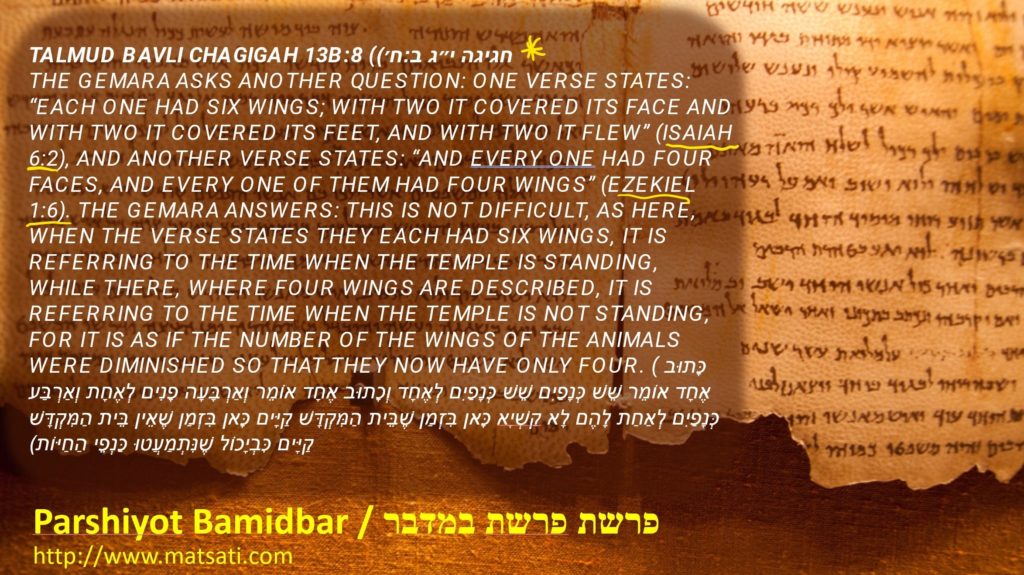
Talmud Bavli Chagigah 13b:8 (חגיגה י״ג ב:ח׳)
The Gemara asks another question: One verse states: “Each one had six wings; with two it covered its face and with two it covered its feet, and with two it flew” (Isaiah 6:2), and another verse states: “And every one had four faces, and every one of them had four wings” (Ezekiel 1:6). The Gemara answers: This is not difficult, as here, when the verse states they each had six wings, it is referring to the time when the Temple is standing, while there, where four wings are described, it is referring to the time when the Temple is not standing, for it is as if the number of the wings of the animals were diminished so that they now have only four. (כָּתוּב אֶחָד אוֹמֵר שֵׁשׁ כְּנָפַיִם שֵׁשׁ כְּנָפַיִם לְאֶחָד וְכָתוּב אֶחָד אוֹמֵר וְאַרְבָּעָה פָנִים לְאֶחָת וְאַרְבַּע כְּנָפַיִם לְאַחַת לָהֶם לָא קַשְׁיָא כָּאן בִּזְמַן שֶׁבֵּית הַמִּקְדָּשׁ קַיָּים כָּאן בִּזְמַן שֶׁאֵין בֵּית הַמִּקְדָּשׁ קַיָּים כִּבְיָכוֹל שֶׁנִּתְמַעֲטוּ כַּנְפֵי הַחַיּוֹת)
Notice how this variation on four versus six wings is discussed in the Talmud, which offers the solution that the living creatures have six wings when the Temple is standing, and four when it is not. The additional wings are used to create a song. John (and evidently Isaiah), had a vision including a Temple in place based upon the rabbinic interpretation. Ezekiel suggests they are guardians, agents / angels of God, bearing his chayot / living creatures whom are constantly doing the will of the Almighty. Ezekiel saw them with each having four faces. Faces are aspects, appearances, what they look like to others who see them. These living creatures were beside God at His throne, and surrounded the Messiah. We note in the account in revelation, the angels then surrounded these things and then the people from all nations surrounded the throne. From a traditional NT perspective, the Messiah Yeshua is the King of Kings (1 Timothy 6:15), the lion is a symbol of kingship. Yeshua was the sacrifice for all who will call upon Him; the ox, calf, lamb, ram, etc were the animals frequently sacrificed according to the Torah. Yeshua had been sent such that we would all be perfected in Him which corresponds to the representation of a man’s face on the living creatures. The Messiah’s judgment is swift and certain; this may be represented in the face of the eagle. it is interesting that the armies God usually used to bring judgment against Israel most often came from the north. The eagle was the emblem of swift, swooping justice, and being on the north side of the camp might have indicated the direction of God’s judgment. (Isaiah 14:31, Jeremiah 4:6, 6:22, 50:9, Ezekiel 1:4, 26:7). The rabbis suggest their faces represented the tribes of Israel around the tabernacle; the lion that of Judah, with Issachar and Zabulon on the east of the camp; the ox / calf that of Ephraim on the west side, with Manasseh and Benjamin; the man was the emblem of Reuben, who was camped on the south with Gad and Simeon; and the eagle that of Dan, encamped on the north with Asher and Naphtali.
What is interesting about these things is reading through Revelation in the past, it always felt as if these living creatures were out of place. Their purpose and place never seemed made sense until studying the Torah and specifically the banners / standard (דִּגְלוֹ) and the symbology of these things couple with the rabbinic tradition and Scripture. These things again reveal to us how every detail in the Torah is so important. This also reveals to us why it is so important for us to study the Torah year after year. There is no scripture that should be considered insignificant or meaningless. Studying God’s Word helps us to know more about Him and our relationship with Him and His Messiah Yeshua. Based upon this study, we can see how we can trust all of Scripture regardless of how difficult the Scriptures may be in our limited understanding of these things!
